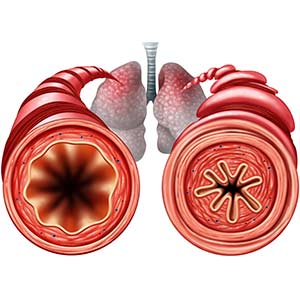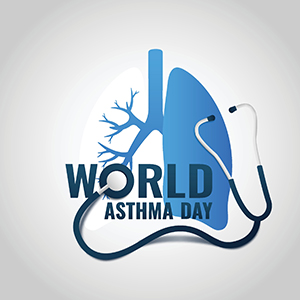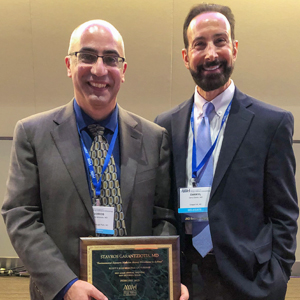On World Asthma Day, May 5, the National Institutes of Health (NIH) reaffirmed its commitment to research to improve the lives of people with asthma.
More than 25 million people in the United States have asthma, including 5.1 million children, according to the Centers for Disease Control and Prevention. This chronic lung disease can reduce quality of life, contributes to considerable emotional and financial stress, and is a major contributing factor to missed time from school and work.
Severe asthma attacks can be life-threatening and may require emergency room visits and hospitalizations. Although asthma can affect anyone, some groups bear a disproportionate burden. For example, Black and Puerto Rican people are at higher risk of asthma than people of other races or ethnicities.
Boosting understanding of the disease
The National Institute of Allergy and Infectious Diseases (NIAID); the National Heart, Lung, and Blood Institute (NHLBI); and the National Institute of Environmental Health Sciences (NIEHS) are the lead NIH institutes that support and conduct asthma research.
 An asthma inhaler. (Photo courtesy of NIAID)
An asthma inhaler. (Photo courtesy of NIAID)Among many other advances, these institutes recently released updated evidence-based guidelines for the diagnosis, management, and treatment of asthma; helped better define the relationship between asthma and COVID-19; and improved understanding of the numerous factors that can influence asthma severity.
Management and treatment
In December 2020, the NHLBI, with input from the National Asthma Education Prevention Program Coordinating Committee, announced the publication of updates to asthma management and treatment guidelines.
The recommendations detailed in the 2020 Focused Updates to the Asthma Management Guidelines are designed to improve patient care and to support informed decision-making about clinical asthma management in six priority areas. These areas include use of inhaled corticosteroids, long-acting muscarinic antagonists, methods to reduce exposure to indoor allergen triggers, immunotherapy, fractional exhaled nitric oxide testing and bronchial thermoplasty.
COVID-19 and asthma
As a respiratory disease, COVID-19 has created particular concern and uncertainty for people with asthma. While some evidence suggests that moderate-to-severe asthma might increase risk for severe illness from COVID-19, two independent, NIAID-supported studies suggest that people with allergic asthma are not at higher risk and identify a potential mechanism.
These studies found that people with asthma and allergic diseases have reduced expression of the human gene encoding the receptor on airway cells that SARS-CoV-2, the virus that causes COVID-19, uses to enter and infect cells. Results anticipated from the NIAID-led Human Epidemiology and Response to SARS-CoV-2 (HEROS) study will clarify whether rates of SARS-CoV-2 infection differ between children who have asthma or other allergic conditions and children who do not.
Environmental influences
In addition to respiratory infections, numerous environmental factors can influence asthma symptoms and severity. A NIEHS-funded study published last year was the first to link reduced emissions from coal-powered plants with asthma-related health benefits, including dramatic drops in asthma symptoms and hospitalizations.
Another NIEHS-supported study found that children, especially boys, with elevated urine levels of bisphenol A (BPA)—a chemical used in food packaging and other consumer goods—had more asthma symptoms. Additional research suggests that exposure to bisphenol F and bisphenol S, two chemicals increasingly used as BPA substitutes, is associated with asthma and hay fever.
The role of genetics
The interplay between genetics and the environment also affects asthma susceptibility and severity. Two NIEHS studies helped clarify how an immune system protein called TLR5 may be involved in worsening asthma in response to environmental exposures.
One study found that the lungs of people with a defective TLR5 generated much less inflammation after exposure to ozone than the lungs of healthy people. A companion study of people with asthma determined that participants who lacked a working TLR5 had fewer asthma symptoms upon exposure to house dust.
NIAID-funded research provided additional insights into why some people develop asthma symptoms when exposed to household dust mites while others do not. In this study, scientists used cutting-edge genomics techniques to identify molecular features of T-cell subsets in people with asthma and allergy to dust mites.
Personalized approach
The complexity of asthma and the broad range of factors that influence an individual’s experience of the disease can pose challenges for managing the condition, suggesting the need for more personalized treatments.
The NHLBI continues to support the Severe Asthma Research Program (SARP), a comprehensive study of adults and children with severe asthma, a debilitating form of the disease that often does not respond well to currently available medications. Findings from SARP informed the development of the NHLBI’s Precision Interventions for Severe and/or Exacerbation-Prone Asthma (PrecISE) Network Study.
PrecISE will evaluate several novel and approved treatments for asthma by targeting them to defined groups of adults and teenagers with severe, poorly controlled asthma who share similar characteristics, such as genetic factors or biomarkers. A recent NIAID-funded study identified immune system characteristics that distinguish subgroups of patients with severe asthma resistant to standard treatment, further helping to pave the way for individually tailored treatments.
Reducing burden on children
NIH also remains dedicated to reducing the disproportionate burden of asthma among children living in low-income urban communities and certain minority populations.
To extend the research performed previously by the NIAID-funded Inner City Asthma Consortium over several decades, NIAID recently funded a new clinical network initiative called Childhood Asthma in Urban Settings, or CAUSE. This program will investigate disease mechanisms and novel prevention and treatment strategies to mitigate the impact of asthma in disadvantaged child and adolescent populations.
A recent NIH-funded study found new genetic variants linked to asthma severity in Puerto Rican children, who have high rates of asthma, that could lead to more targeted treatments in this group. The study includes genetic data from the NHLBI’s TOPMed Program, which seeks to understand the genetic underpinnings of disease, including asthma.
Working together
As we reflect on the progress that has been made against asthma and the challenges that remain, NIH extends its gratitude to all who help make advances in care possible—from scientists and health care professionals to clinical research volunteers, advocates, and educators.
Together, we continue to advance our shared mission to develop and implement effective strategies for the management, treatment, and prevention of this chronic lung disease.









